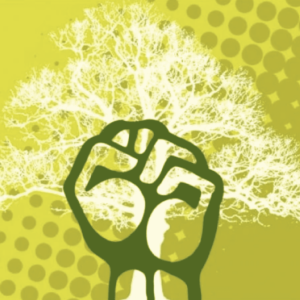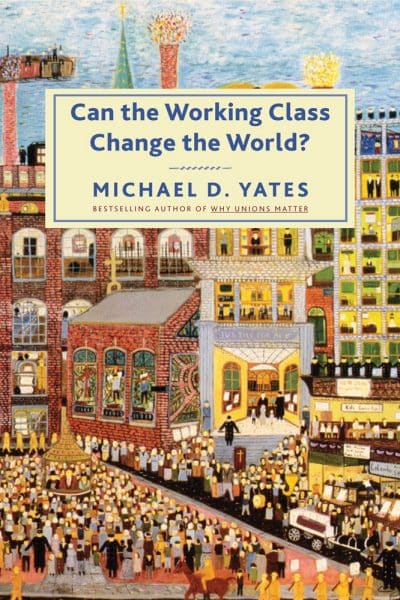Can the Working Class Change the World?
218 pp, $19 pbk, ISBN 978-1-58367-710-0
By Michael D. Yates
Reviewed by Kevin Sapere in Socialism and Democracy
It is a daunting task to review a book from an author like Michael Yates. For many, Yates’s books have played an indispensable role in helping to develop a Marxist understanding of the world and how to change it. His latest book, Can the Working Class Change the World?, makes an important contribution to this project.
Like much of Yates’s writing, Can the Working Class Change the World? is written in a style that is easily accessible without sacrificing its ability to engage with complex ideas. The book seeks to answer the question suggested in the title. Spoiler alert: the answer is yes. Riddled throughout with anecdotes and stories, Yates introduces and probes Marxist categories in a refreshingly non-dogmatic way.
Yates discusses what the working class is and how Marx and other Marxists have theorized its exploitation and liberation. In each case, Yates breaks with old tablets and incorporates recent scholarship in areas such as social reproduction into his analysis. For Yates, “if we assumed that a necessary condition to be included in the working class is wage labor, we will miss hundreds of millions who are not paid wages but labor in such a way that capital benefits” (12). Therefore, a more thorough definition of the working class depends on an exploration of the social relations that are constitutive of capitalist accumulation, such as socially reproductive activities and other forms of labor not typically associated with the working class under the restricted definition of wage labor. Drawing from the work of Ursula Huws, Yates breaks up these social relations into two camps: labor that reproduces capital-labor relations, and labor that increases the profits of individual businesses (17). This dichotomy allows Yates to explore a definition of the working class that moves beyond simplistic caricatures of industrial wage laborers, while also demonstrating how as these relations become more entwined (many workers fall into both camps) the power of workers to bring capital to a halt is amplified.
Yates also seeks to build a theoretical “scaffolding,” allowing him to explain Marx’s theory of exploitation as it relates to other categories such as oppression and colonialism (33). While attempting to explain Marxist economics, patriarchy, racism, and colonialism in a single chapter is a near impossible feat, Yates’ ability to more than adequately do just that is testament to his abilities as a writer. He locates the roots of exploitation in the production of surplus value in a detailed discussion of Marx’s famous equation, M-C-M’. While some of Yates’ discussion seems incomplete (specifically his discussion of patriarchy and the origins of women’s oppression), what Yates successfully demonstrates is how capitalism was built on a foundation of oppression, subjugation, and dispossession, therefore illustrating how exploitation and varying forms of oppression are co-constitutive parts of a single totality.
Yates continues his exploration of the working class’ ability to change the world by exploring historical understandings of the working class and class struggle. Yates discusses the closing line of the Communist Manifesto, “Proletarians of all countries, Unite!” after which he explores the early history of the working class and why Marx and Engels understood workers to be the revolutionary agent of change, whose liberation would spell the end of class society. Yates offers a brief historical overview of what workers’ struggle looks like, from unions and strikes to the Russian Revolution of 1917, and the shortcomings of labor and social democratic parties in Europe. Yates is careful not to portray the working class as homogenous (as is so often the case), instead he takes time to explain the heterogeneous character of the class and points of contention that capital has exploited for its benefit.
Yates analyzes how, in the face of periods of crisis and struggle, capitalism survives. He traces the end of the post-war boom years to the founding of the neoliberal world order. Central to his analysis is the disastrous pact made by labor with the bosses in the US that “meant that when capital discarded the accord [with labor] in the 1970s and embraced neoliberalism, the unions were unprepared” (127). This ushered in a new period of unprecedented capital accumulation simultaneous with unheard of levels of inequality and suffering.
Yates does not end on a depressing note. His final chapter definitively answers the question in the book’s title – not only Can the Working Class Change the World? it continues to do so in both big and small ways. From farm and agricultural workers’ movements to landless peasants reclaiming land in Central and South America, to rank-and-file union movements in the US, workers have continued to struggle despite neoliberalism’s offensive. Yates describes how the rugged individualism of capitalism is not inherent to humanity but had to be forced and continually instilled. Indeed, the first act of capital as it made its appearance on the world stage was to divorce the producer from their means of production and reproduction. As Yates argues, “what the exploitation and expropriation central to capitalism meant historically was a war, waged by law and by violence, against common ownership and customary group rights” (141). Therefore, Yates proposes, “if the working class is to radically change the world” it must wage a war “against the I and for the we.” Yates’s formulations are then used to explore the myriad ways in which workers continue to push back against capital in the interest of “the we.”
While exploring various terrains where workers have struggled against capital and its domination of our lives, Yates takes a decidedly unorthodox approach. He spends a fair amount of time explaining the importance of reclaiming common spaces and “commoning” practices. From community gardens to education, Yates outlines the different ways in which workers have reclaimed the commons – a form of class struggle too often ignored. But none of this is posed as separate from more traditional forms of class struggle in the workplace. Indeed, Yates demonstrates how struggles in the workplace and fights to reclaim commons are part of the larger battle against capitalism’s hegemony.
There is no substitute for reading Marx. One of the shortcomings of education on the left in recent decades has been the discouragement of reading primary texts. With that being said, there is also a role for introductory and analytical texts for both activists and academics alike. Can the Working Class Change the World? stands out as a useful introduction to Marxism and working-class politics. Michael Yates has the unique ability to introduce Marx’s approach in a way that engages both recent scholarship and the various creative ways in which workers are struggling. In doing so, it can serve as an important tool in the labor movement and the classroom. Read alongside primary texts, this book can demonstrate that not only was Marx correct about the revolutionary potential of the working class, but that workers continue to be the engine of change in varied and inspiring ways…
For more, head to Socialism & Democracy


Comments are closed.